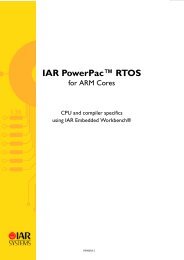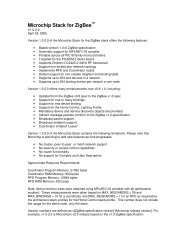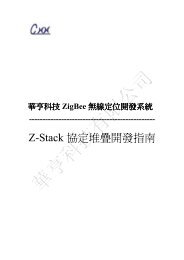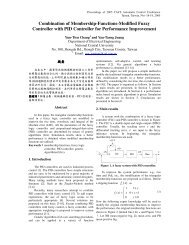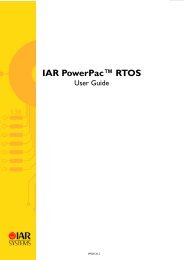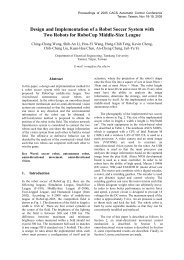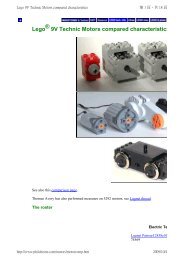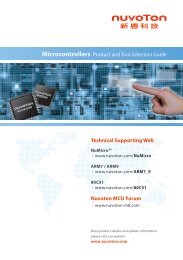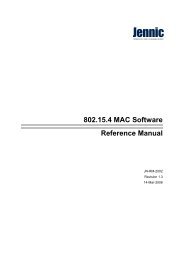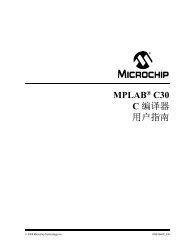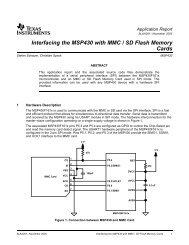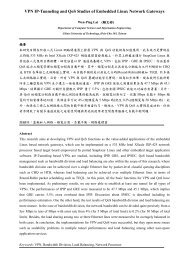Learning digital control systems with a low-cost educational platform
Learning digital control systems with a low-cost educational platform
Learning digital control systems with a low-cost educational platform
You also want an ePaper? Increase the reach of your titles
YUMPU automatically turns print PDFs into web optimized ePapers that Google loves.
Proceedings of 2005 CACS Automatic Control ConferenceTainan, Taiwan, Nov 18-19, 2005<strong>digital</strong> feedback <strong>control</strong>ler is given to students suchthat they can modify the <strong>control</strong>ler parameters andeven the <strong>control</strong>ler structure [6] to see if the responsescoincide <strong>with</strong> the theoretical predictions. If not,double check of the software codes and theories canmake them more familiar <strong>with</strong> problem-solvingtechniques. Experimental results which compare theperformances of the servo <strong>control</strong> of dc motors <strong>with</strong>and <strong>with</strong>out the anti-windup function are shown infigure 5. The robustness of the <strong>digital</strong> temperature<strong>control</strong>ler is shown via experimental results in figure 6by changing the amount of water in the water tank.Figure 5. The experimental results of <strong>digital</strong> servo<strong>control</strong> of DC motors <strong>with</strong> and <strong>with</strong>out anti-windupfunction4. ConclusionsA <strong>low</strong> <strong>cost</strong> <strong>educational</strong> <strong>platform</strong> is devised in thispaper. It can be constructed for servo <strong>control</strong> of dcmotors and temperature <strong>control</strong> of a water tank forless than USD$ 50. Two experiments are devised tohelp students become familiar <strong>with</strong> the necessary<strong>control</strong> theories and the corresponding softwareimplementation for the servo <strong>control</strong> of a dc motorand temperature <strong>control</strong> of a water tank. This canhelp encourage students to make their own<strong>educational</strong> <strong>platform</strong> and learn to solve by themselvesmore practical <strong>digital</strong> <strong>control</strong> problems. To make the<strong>educational</strong> <strong>platform</strong> more versatile, the USB portshould be used to increase the communication speedbetween the <strong>educational</strong> <strong>platform</strong> and the personalcomputer. This may be done <strong>with</strong> the help of theUSB interface device [11]. Moreover, the <strong>digital</strong>signal <strong>control</strong>ler (dsPIC) provided by the MicrochipTechnology Inc. is another affordable choice ofmicro-<strong>control</strong>ler for its fast computational speed andversatility. It is also easy to setup the developmentenvironment for the <strong>digital</strong> signal <strong>control</strong>ler (dsPIC)<strong>with</strong>out too much money.Figure 6. Robustness analysis of the <strong>digital</strong> PIDtemperature <strong>control</strong>ler <strong>with</strong> and <strong>with</strong>out anti-windupfunctionSince tuning of PID <strong>control</strong>ler parameters may betedious in practice, techniques in auto-tuning of<strong>control</strong>ler parameters [2, 4] are introduced to studentsafter they successfully apply theories to design PID<strong>control</strong>lers in both the problems. Because of thecomputational complexity, the self-tuning adaptivefeedback <strong>control</strong>ler for servo <strong>control</strong> of dc motors byusing recursive least square (RLS) estimation can onlybe demonstrated in our dSPACE real time <strong>control</strong>environment if the order of the reference model isgreater than or equal to 2. The student can stillimplement a convergent RLS algorithm on the<strong>educational</strong> <strong>platform</strong> if the sampling frequency is nottoo high and a reference model of order 1 is used.Figure 7 shows the experimental results of asuccessful self-tuning adaptive feedback <strong>control</strong>ler,whose reference model is of order 1. On the otherhand, the algorithm described in [5] for on-lineidentification of system parameters and auto-tuning ofPID <strong>control</strong>ler parameters can be successfullyimplemented in the <strong>educational</strong> <strong>platform</strong>, because thedynamics for heat transfer in the temperature <strong>control</strong>of a water tank is s<strong>low</strong>.Figure 7. The experimental results of a successfulself-tuning adaptive feedback <strong>control</strong>ler, whosereference model is of order 15. References[1] D. S. Bernstein, “Enhancing undergraduate<strong>control</strong> education,” IEEE Control SystemsMagazine, pp. 40-43, October 1999.[2] Y.-C. Chen and J. M. Naughton, “Anundergraduate laboratory <strong>platform</strong> for <strong>control</strong>system design, simulation, and implementation,”IEEE Control Systems Magazine, pp. 12-20,June 2000.[3] G. F. Franklin, J. D. Powell, and A.Mami-Naeini, Feedback <strong>control</strong> of Dynamic<strong>systems</strong>, 4 th edition, , chapter 2, Prentice-Hall,Inc., 2002.




